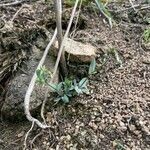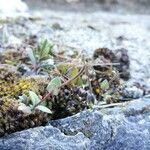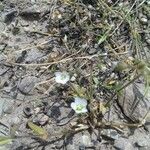Stems 1-6-(10), erect, glabrous or glandular, 5-15-(20) cm tall. Basal lvs narrow-oblanceolate to narrow-spathulate, subacute at apex, cuneate at base, 10-25 × 2-5 mm, glabrous or sparsely ciliate. Stem lvs distant, opposite, ovate, obovate or spathulate, glabrous or ciliate, 5-15 × 2-5 mm. Bracts crowded, ovate, green or purplish with wide scarious margins, 1-1.5 × 0.5 mm. Pedicels glabrous, recurved at flowering, erect at fruiting, (5)-10-20 mm long. Sepals narrow-ovate, obtuse; margins scarious, 3-5 × 1-2 mm. Petals white, slightly > sepals. Stamens usually 3, slightly < sepals. Styles 3, c. 1.5 mm long. Capsule broadly cylindric, or ellipsoid, 4-5-(6) mm long, dehiscing by 6 recurved teeth. Seeds pale brown, about 1 mm long.
Annual, somewhat glaucous; stems tufted, unbranched, 1–3 dm, stipitate-glandular especially near the middle, generally glabrous at top and bottom; lvs stipitate-glandular around the margins, the basal ones tufted, oblong to oblanceolate, 1–2.5 cm, often short-petiolate, the cauline few and sessile; peduncle much surpassing the lvs, with 3–15 fls on slender pedicels that elongate to 1.5–3 cm in fr; sep ca 3 mm at anthesis, somewhat accrescent; pet generally a little longer than the sep; stamens 3–5, alternipetalous; capsule well surpassing the cal, its valves ± strongly outrolled from the tip; seeds 1 mm; 2n=20. A weed of waste places, native to Eurasia, widely intr. in the U.S. and nearly throughout our range. Apr–May.
Stems erect, 5--20 cm tall, simple or branched, usually glaucous toward base, glandular viscid. Basal leaves narrowed into petiole, oblanceolate; cauline ones sessile, elliptic, 1--3 cm × 3--6 mm, abaxially pubescent, margin ciliate, apex acute. Flowers in umbels. Pedicel deflexed after anthesis, erect in fruit, 1--1.5 cm, slender, pubescent. Sepals oblong, 3--4 mm, abax-ially pubescent, margin membra-nous, apex obtuse. Petals white or pale pink, oblong, subequaling or longer than sepals, apex dentate. Stamens 5. Capsule cylindric, somewhat narrowed above, ca. 2 × as long as sepals. Seeds reddish brown, 0.5--1 mm. Fl. May--Jul, fr. Jun--Jul. 2n = 20.
An annual herb. The stems are erect and 5-20 cm tall. The leaves at the base narrow into the leaf stalk. The leaves on the stem are 1-3 cm long and 3-6 mm wide.



